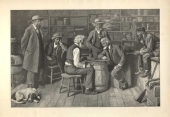The Checker Maven
The World's Most Widely Read Checkers and Draughts Publication
Bob Newell, Editor-in-Chief
Published every Saturday morning in Honolulu, Hawai`i
Noticing missing images? An explanation is here.
Holiday Magic

Whatever holidays you celebrate, everyone loves this time of year when the very air seems filled with magic. As our holiday offering to you, we present a problem from a little booklet called Modern Magic, published long ago and featuring the miniatures of S. J. Pickering. Here's our holiday situation:
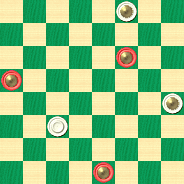
WHITE
White to Play and Draw
W:W22,K20,K3:BK31,K13,K11.
White's enjoyment of the holidays looks as though it's about to be spoiled, as he appears to be in a very un-festive predicament, with his king on 3 trapped and his man on 22 at risk. Can you pull off some magic of your own and save the season for White? Earn yourself a cup of holiday cheer by solving today's problem. There's no danger, though, of spoiling your own seasonal enjoyment, as clicking on Read More will, as if by magic, bring the solution to you.
The Checker Maven wishes the best of the season to one and all.![]()
Showdown in Abilene
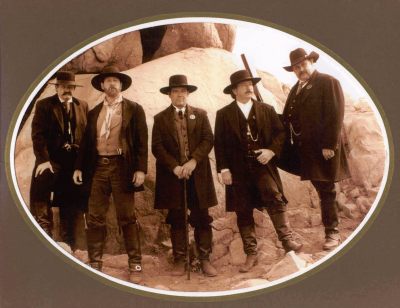
Abilene Texas is cowboy country, partner, you just better believe it. The home of many a Hollywood showdown between the guys in the white hats and the guys in the black hats, Abilene is practically synonymous with the Wild West.
It's perhaps less well-known but every bit as important (at least to us) that Abilene has a history of great checker shootouts too. We recently came across the results of the 8th Semi-Annual West Texas Tourney, held on Washington's Birthday in 1935, and surely Abilene rocked and reeled that day, not from gunshots, but from the excitement of high-class competitive checkers.
We've chosen a situation from a game between a Mr. Geo. R. Gristy, of Eastland Texas (playing White) and Mr. A. H. Tate of Olden Texas (playing Black).
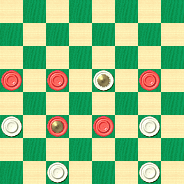
WHITE
White to Play and Win
W:W32,30,24,21,K15:B13,14,16,23,K22.
Believe it or not, there's only one winning move. Everything else draws or loses. Here Mr. Gristy played 24-20, allowing Mr. Tate to come up with a spectacular draw.
Can you win this unexpectedly difficult shootout? Can you figure out what Mr. Gristy should have played to win with the White side (instead of 24-20)? Can you show how Mr. Tate cleverly drew after 24-20?
Fight for the solutions, and then shoot back in time with us to Abilene Texas, 1935, to see the full game, explanatory notes, and the surprising answers. All it takes is a simple click on Read More.![]()
Our Second Anniversary: Let's Have Coffee and Cake!
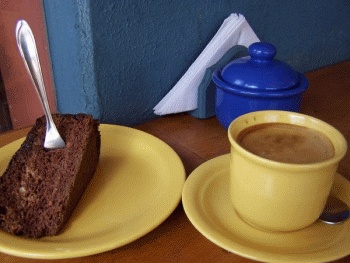
With this issue, The Checker Maven celebrates two full years of uninterrupted, on-time weekly publication, something that we believe no other internet checker webzine has ever accomplished. Over the past 24 months, we've seen our weekly readership grow from a handful to several thousand, as The Checker Maven has become a Saturday morning staple for many a checker enthusiast. By any measure, it's the world's most widely read checkers and draughts publication.
For our part, we're grateful to all of you for making us a success far beyond anything we would have ever believed possible, and we hope to be able to continue to publish for a long time to come.
To celebrate the day, we'd like to go back to our favorite "coffee and cake" theme. This is an idea created by none other than Willie Ryan, about a problem that you'd set up for your checker pals and bet them coffee and cake that they can't win it. Well, today's coffee and cake problem gives them a fighting chance. It isn't really that difficult if you can see the winning method, so you might actually have to pay up on this one.
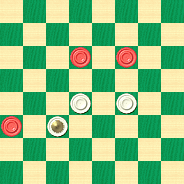
WHITE
White to Play and Win
W:WK22,19,18:B21,11,10.
Our thanks to Brian Hinkle, to whom we owe coffee and cake many times over, for sending us this problem. Solve it, check your solution by clicking on Read More, and then treat yourself--- to coffee and cake, of course.![]()
The Long Road Home

It's Thanksgiving Weekend in the United States, a very special and very American holiday, and a weekend on which many people travel long distances to be home with family. Whether you've been able to stay close by, or have yourself journeyed on that long road home, The Checker Maven wishes you the all best of this, our favorite holiday by any measure.
For Thanksgiving Weekend, we bring you a special installment of Checker School with an instructive pair of situations from Ben Boland's classic reference, Famous Positions in the Game of Checkers. Here's the first one, and it illustrates today's theme of traveling far to reach your goal:
WHITE
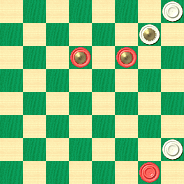
BLACK
Black to Play and Win
B:W29,K25,5:BK23,K22,1.
Black can win this position, just barely, but it requires a lot of clever maneuvering and a good dose of patience. Are you methodical enough to work it out? Can you visualize far enough ahead to find the solution without moving pieces on a board? It's quite a challenge, and indeed a long road home.
Here is a much easier one, which arises from a variant of the tougher one above:
WHITE

BLACK
Black to Play and Win
B:W17,5:BK10,1.
The solution is very neat and not all that difficult to find. Can you do it?
Whether you in fact find your way, or remain lost, clicking on Read More will guide you on the path to Ben Boland's solution, descriptive notes, example games, and entertaining comments.![]()
The Captured Bear

Brian Hinkle's ferocious bear is finally captured in today's Checker Maven column.
No, we did not receive any correct solutions. We did receive some pretty good attempts; and we also heard from a few skeptics who claimed the setting was wrong to begin with.
So, at long last, we present Brian's solution to what we believe is destined to become an enduring, classic problem--- a great new variation on a theme which, strangely enough, has been around for quite a number of years.
To refresh your memory, here's the situation:
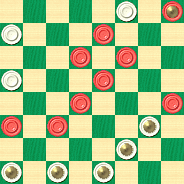
BLACK
Black to Play and Draw
B:W30,28,20,K9,K6,K4,K3,K2:BK29,26,23,22,18,15,13,12,11.
| 1. | 11-16 |
Alternatively, Black can first play 22-25, 30-21, 18-22 and the results are almost the same.
| 1. | ... | 20x11 |
| 2. | 22-25 |
This is the second, necessary pitch, that removes the "clutter."
| 2. | ... | 30x21 |
| 3. | 18-22 |
Moving to start the formation of a 4-piece "clover leaf of safety."
| 3. | ... | 28-24 |
If ... 6-10 then black can immediately complete the "clover leaf of safety" with 15-18 and white cannot penetrate the position, for instance 10-15 12-16 15-19 16-20 19-15 29-25 15-19 and then the black man can simply stay on square 20, or black can play 20-24 and we are headed back toward the final position as played out in the main line, which continues below
The main line move as given (28-24) instead sets a trap for black.
| 4. | 12-16 |
Moving the piece farthest from the king row, and at this point the only move that draws. If black instead rushes to complete the "clover leaf of safety" with 15-18 then 24-19! and white wins as now the man on 12 cannot advance.
| 4. | ... | 4-8 |
| 5. | 15-18 |
This now completes the aforementioned 4-piece "clover leaf of safety."
| 5. | ... | 24-20 |
| 6. | 16-19 | 6-10 |
| 7. | 19-24 | 8-12 |
| 8. | 24-27 | 11-8 |
| 9. | 27-32 |
This black king will stay permanently on square 32 and complete the defensive barricade on the double corner side.
| 9. | ... | 8-4 |
| 10. | 29-25 |
And this is the king that will "wiggle forever."
| 10. | ... | 4-8 |
| 11. | 25-30 | 8-11 |
| 12. | 30-25 | 21-17 |
| 13. | 25-29 | 17-14 |
| 14. | 13-17 | 9-13 |
| 15. | 17-21 |
Drawn.
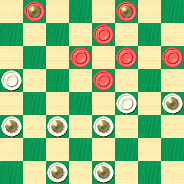
BLACK
This is now the draw formation attributed to Dr. T. J. Brown in Ben Boland's Masterpieces in the Game of Checkers, p. 155, diagram C.
Note that all seven black pieces are required and must be in position to obtain the draw.
- Four men form the "clover leaf of safety" which cannot be attacked due to
- the black king parked on square 32 (which itself cannot be drawn away), and
- the unassailable black man on 21, protecting against white incursions into the single corner, while
- the king in the single corner "wiggles" forever, watching white's futile efforts play themselves out.
It is amusing that white can move a king or kings onto squares 19, 24, 27, 28, and 31 without any effect whatsoever! Black simply ignores these efforts and continues to "wiggle" his single-corner king among squares 30, 25, and 29.
The "Bear Claw" is surely a unique and brilliant problem that will entertain checker fans for generations to come.


"The Clover Leaf Of Safety" and "The King That Wiggles Forever"
![]()
A Cross Loss

Are you cross when you find yourself in a loss?
Today's installment from our ongoing republication of Willie Ryan's unmatched Tricks Traps & Shots of the Checkerboard deals not with crossness, but with the Cross opening (more accurately, the Cresent Cross), and a neat trap that, should you fall into it, might indeed lead to a cross disposition. But you can avoid this terrible fate by studying this example and paying attention to Willie as he explains as only he can do.
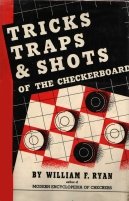
An Interesting Cross Loss
"The 26-23 line of the cross (4th move) has never enjoyed the same popularity among top-notchers as that of the 27-23 build-up. I am among the few moderns who are partial to it. The play presented on the next page reveals the one trap I have used most frequently with the white pieces:
11-15, 23-18, 8-11, 26-23, 10-14---A, 30-26, 7-10---C, 24-19, 15-24, 28-19, 11-16, 22-17, 4-8, 26-22, 9-13---D, 18-9, 5-14, forming the diagram.
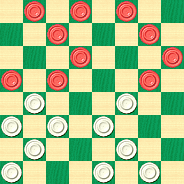
WHITE
White to Play and Win
W:W17,19,21,22,23,25,27,29,31,32:B1,2,3,6,8,10,12,13,14,16.
A---If 4-8 is used, then proceed with 30-26, 10-14, 24-19, 15-24; at this point, 27-20* is still essential, as 28-19 loses by 11-16, 32-28---B, 6-10, 22-17 (27-24, 8-11; now 22-17 is beaten by 11-15, and 24-20 by 10-15), 8-11, 26-22 (if 17-13, 10-15 wins), 1-6, 17-13, 14-17, 21-14, 10-26, 31-22, 7-10, 25-21, 16-20, 29-25, 3-7, 22-17, 9-14, 18-9, 5-14, 19-15, 11-18, 23-19, 7-11, and black wins. Wm. F. Ryan vs. H. L. Rudolph.
B---22-17, 8-11, 17-10, 6-24, 27-20, 9-14, 18-9, 5-14, 25-22, 16-19, 23-16, 12-19, 22-17, 7-10, 29-25, 3-8, 17-13, 8-12, 25-22, 11-15, 22-17, 14-18, 17-14, 10-17, 21-14, 18-23, 26-22, 23-26, 14-10, 26-30, and black wins. Wm. F. Ryan.
C---If 6-10, 24-19, 15-24, then 27-20* is correct to draw; but 28-19 loses by 11-16, 18-15 (22-17 loses immediately by 10-15), 1-6, 15-11, 14-18 *, 22-15, 9-14, 26-22, 14-18, 23-14, 16-23, 27-18, 10-26, 31-22, 7-16, 21-17, 3-7, 25-21, 16-19, 32-27, 7-10, 15-11, 2-7, etc., and black wins. Wm. F. Ryan. This win corrects draw play by Hugh McKean, W. D. Benstead, and others.
D---Tempting, but fatal. The correct play is 16-20, 17-13, 8-11, 22-17, 12-16*, 19-12, 10-15, 17-10, 15-22, 25-18, 6-22, 13-6, 1-10, 21-17, 5-9, 23-18, 9-13, 32-28, 11-16, 27-23, 2-7, 18-14, 10-15, 23-18, etc., resulting in a draw. Wm. F. Ryan."
Don't be cross yourself if you have trouble finding the solution; click on Read More to see how Willie does it.![]()
Roybn's Fast Shots

This month's speed problems were contributed by a GoldToken player who calls himself Robyn Hode. Though we're not informed about his archery skills, he's certainly a fine checkerist, as these "fast shots" will show. They are relatively easy, so we won't give you much time to fire your bolt. The first problem arises from a common beginner's blunder in the Single Corner opening. The second problem is adapted from Italian checkers.
November Speed Problem 1. 5 seconds; very easy.
November Speed Problem 2. 15 seconds; fairly easy.
Quickly find the target, but there's no need to quiver; clicking on Read More takes you straight as an arrow to the solutions.![]()
Cornered

This installment of Checker School is one that we really enjoyed working on, as it's got a lot of good, practical playing instruction in it.
We have a situation in which, though the White forces are well-advanced down the board, they seem to have been pretty well cornered by the Black team. It's a tough predicament to be in, but there is a very clever draw for White---- if you can see it. This one is well worth learning, as we're sure you'll see similar themes in many of your own games.
BLACK
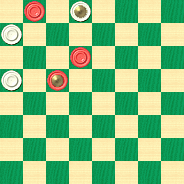
WHITE
White to Play and Draw
W:W13,5,K2:BK14,10,1.
Can you find White's way out of the box? One wrong move and it's curtains! But don't despair. Try to find the answer, but if you've still got your back to the wall, clicking on Read More will lead you safely to the solution, along with a sample game and some deep and detailed analysis.![]()
A Good Start

Our feature problem today is another elegant Tom Wiswell offering, one in which a good start is essential. Let's get right down to business:
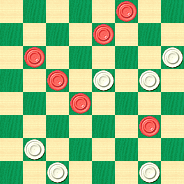
WHITE
White to Play and Win
W:W12,15,16,25,30,32:B3,7,9,14,18,24.
A quick review of the position shows that, while a White win is anything but obvious, there are two likely-looking moves for White to play. Yet, as you might expect, only one of them will work.... but which one? Getting a good start here is vital!
Can you find the correct move for White, and the follow-up that will carry the day? We'd rate this one as "not so easy" but certainly solvable--- with a good start.
Work out your line of play, but don't worry; clicking on Read More will start you on your way to the finish line with the solution and some helpful notes.![]()
The Lost Soul

This month's speed problems come from actual play on the GoldToken turn-based game site. The first one is a nice win crafted by a rather skilled player who calls himself Lost Soul for reasons to which we are not privy; but this skilled player is anything but lost when playing over the board! The problem is in the easy category, and we're allowing you 15 seconds to solve it.
The second problem is a neat victory gained by Larry OTC. Again, we're not sure what "OTC" means, but we doubt that it's "over the counter"; could it be "one terrific checkerist"? Only Larry knows for sure; but we rate the problem as medium in difficulty and give you 60 seconds to find the right moves.
October Speed Problem 1 (easy)
October Speed Problem 2 (medium)
Don't lose your own soul over these problems; salvation is at hand by simply clicking on Read More to see the solutions.![]()
The Checker Maven is produced at editorial offices in Honolulu, Hawai`i, as a completely non-commercial public service from which no income is obtained or sought. Original material is Copyright © 2004-2026 Avi Gobbler Publishing. Other material is public domain, AI generated, as attributed, or licensed under CC1, CC2, CC3 or CC4. Information presented on this site is offered as-is, at no cost, and bears no express or implied warranty as to accuracy or usability. You agree that you use such information entirely at your own risk. No liabilities of any kind under any legal theory whatsoever are accepted. The Checker Maven is dedicated to the memory of Mr. Bob Newell, Sr.

